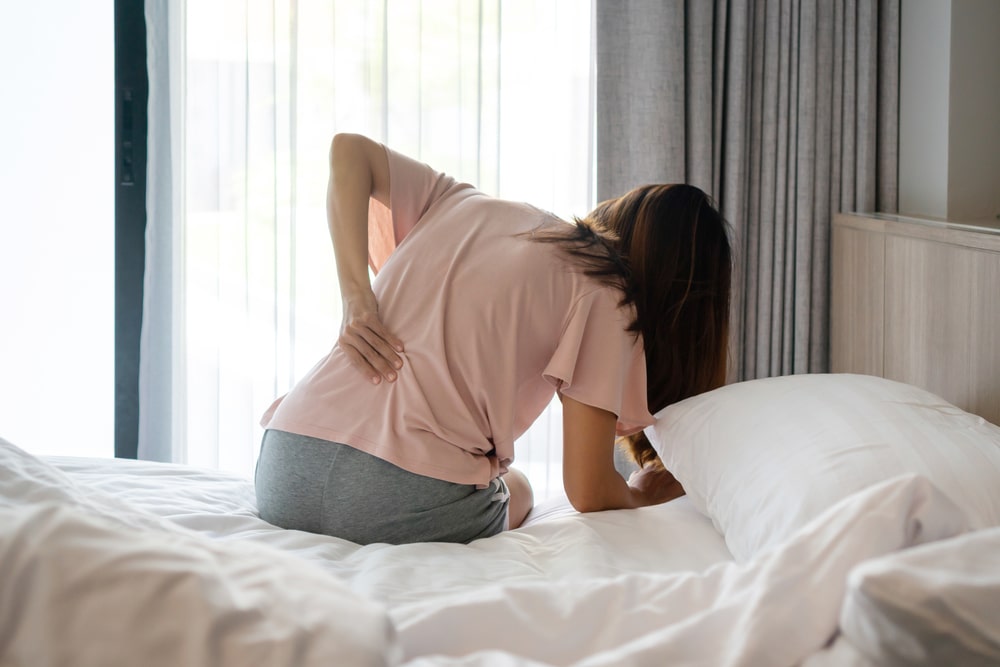If your back hurts when you lie down, it could be so severe that it makes it impossible for you to carry on with your daily activities. Having pain at night can make it challenging to get enough sleep. You may be affected throughout the day as well. There are many possible causes. You might have a strain or another type of injury. Or you might have a medical condition like sciatica or arthritis. Are you looking for the answer of why does my back hurt when I lay down?
This article will look at a few factors that may give you back pain while lying down. It also explains its treatment options.
What Are the Cause of Lower Back Pain When Lying Down
It’s typical to experience infrequent pain when lying down could be caused by anything as simple as a physically demanding day or sleeping in an unusual position. Particularly if it disappears after a restful night of sleep, this is rarely an indication of a serious health issue. This pain can, however, also result from more severe problems, so it’s crucial to keep an eye on it when it happens. Let’s uncover the reasons of spine hurts when I lay down.
Here are some probable causes why you might experience back pain when you lie down.
Poor Posture
People who aren’t very active, spend a lot of time sitting at a bench or have bad posture may have hip flexors that can tighten up more than they should. As the lower side of the back curves inward, this can result in dull, aching pain. Your spinal discs are then put under pressure by this rounding, which makes lying flat painful as your body tries to make up for the rounding.
Ankylosing Spondylitis (AS)
Ankylosing Spondylitis is a unique type of arthritis that affects the neck and back chronically. Commonly, the lower side of the back and pelvic region are the areas of AS pain. Frequently, the pain gets worse when you’re less active at night.
Pulled muscle or strain
Lifting or twisting improperly can result in muscle strain. Sprains and strains stretch and tear muscles and ligaments, which are the most frequent causes of lower side of back pain. These typically hurt all day long, but lying flat could worsen it.
Disc degeneration
Degenerative disc disease is a term that is frequently used to refer to this condition. DDD isn’t a disease, despite the name. It is a condition that worsens over time as a result of damage sustained in an accident or from wear and tear.
Sciatica
The pain can extend down the legs when the back vertebrae annoy the sciatic nerve. Numbness and tingling may bring this pain and make it worse in certain sleeping positions.
Spinal tumor
You might have a tumour or expansion in your spine if your back pain has worsened all the time. Because of the direct strain on your spine, lying down may worsen your pain.
Kidney stones, a hint of pregnancy, or other types of arthritis are some additional potential causes.
Preventing Lower Back Pain When Lying Down
Lower back pain can be a significant hindrance to daily life, and understanding how to prevent it, especially when lying down, is crucial. The causes of lower back pain are varied, and managing them often requires a multifaceted approach.
Strengthening and Nutrition: Building a Stronger Back
- Regular Exercise: Engaging in physical activities strengthens the spine-supporting muscles. Inactivity can lead to weak muscles, causing instability and pain.
- Nutritious Diet: A diet rich in calcium and vitamin D is essential for bone health, crucial for a strong backbone.
- Maintain Healthy Weight: Keeping a balanced weight reduces strain on the spine, preventing pain and slowing down intervertebral disc degeneration.
Lifestyle Adjustments for Back Health
- Quit Smoking: Smoking impairs blood flow to the lower back, leading to spinal issues. Stopping smoking is vital for overall spinal health.
- Physiotherapy: For those already experiencing back pain, a physiotherapist can suggest exercises to stabilize the spine and alleviate pain.
Ergonomic Practices and Proper Posture
- Workspace Ergonomics: An ergonomic workspace and frequent breaks from sitting can prevent back pain caused by prolonged hunching.
- Lifting Techniques: Use proper lifting techniques, avoiding twisting motions that can strain the back.
- Footwear Choices: Opt for comfortable, low-heeled shoes to avoid altering spinal alignment and causing back pain.
Choosing the Right Mattress
- Firm Mattress Benefits: A firm mattress offers adequate spinal support. An old or unsupportive mattress can cause excessive curvature of the spine and lead to pain.
By incorporating these practices into your daily routine, you can significantly reduce the risk of experiencing lower back pain, ensuring both comfort and a healthier back.
Why Back hurts when I lay down: pain treatment
Depending on the diagnosis, there are various treatments for lower side of back pain. You can try short-term therapy at your home to relieve minor pains and aches. Home treatment options include:
- switching positions while sleeping
- sleeping with your legs & knees elevated
- using heat pads
- Utilising extra medications
- trying to get a massage
Refrain from letting yourself sit around or doing something for too long. To avoid stiffness, you should put off doing any physical activity for some days & then gradually ease return into your regular activities. After some time, slight lower back pain typically goes away by itself. Consult your doctor about your situation if it doesn’t.
Treatments for AS (Ankylosing Spondylitis)
Depending on your case’s severity, you may need to receive treatments for ankylosing spondylitis. Your physician might suggest nonsteroidal anti-inflammatory medications (NSAIDs). In any case, the NSAIDs are ineffective, your doctor may suggest biological drugs like an interleukin 17 (IL-17) inhibitor or a tumour necrosis factor (TNF) blocker. If one joint pain is very serious, you might need surgery.
Recommended: How to Distract Yourself From Pain
Treatments for spinal tumor
The course of treatments for a spinal tumour depends on how severe the tumour is. To assist for the prevention of spinal cord nerve damage, your doctor might advise surgery or radiation treatment. Early diagnosis of symptoms increases your opportunity for speedy recovery.
Treatments for degenerative discs
Degenerative discs are normally medicated with nonsurgical approaches, such as pain treatment, physical medication, work out and fat loss.To get treatment for spinal pain when lying flat on back, one should consult with an
Treatment for degenerative discs typically involves nonsurgical methods like painkillers, physical therapy, massage, exercise, and weight loss. Surgery is frequently complicated, so it is put off until all other options have failed.
Conclusion
You likely have a pull or a tweak in your back side muscles if your back hurts when you laying flat on your back. The pain have to go away with time and rest. Consult your doctor if you experience back problems when you lay down that worsen over time; you could be dealing with a more complex situation. Qualified back pain experts will recommend specific drugs, procedures, and psychotherapy to relieve back pain at night effectively.
There are numerous reasons why back pain while lying down may occur. Some are more serious than others. Discovering the source of your pain is crucial, especially if it stops you from sleeping. A muscle strain is the most typical cause. Back pain at night can also be brought on by sciatica, various forms of arthritis, and spinal changes. A professional medical needs to know what causes your pain, when it started, and how it improves or worsens. To determine the cause for why my back hurts when I lay down, you might also require bone scans or lab tests.
Medical Disclaimer: This information is for educational purposes only and not a substitute for professional medical advice. Always consult a healthcare provider.



